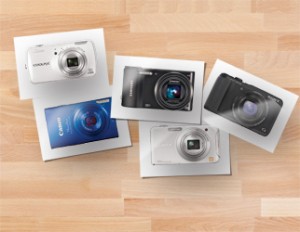Connected cameras: Best Wi-Fi devices
Say goodbye to those clunky cables: now you can wirelessly connect to the web for instant photo sharing. But which of these Wi-Fi cameras should you focus on?
Advertisement
Say goodbye to those clunky cables: now you can wirelessly connect to the web for instant photo sharing. But which of these Wi-Fi cameras should you focus on?
 Time was, if you wanted a pocket-portable device capable of snapping pictures and instantly sharing them on the web, you had one logical choice: the smartphone, featuring network connectivity and a camera. But while iPhones and Androids are fine for mobile Internet access, they aren’t always the best for photography. Their cameras tend to be relatively basic compared with the advanced feature sets on modern point-and-shoot cameras.
Thankfully, point-and-shoot makers have started offering cameras with Wi-Fi. Now you can capture sharp pictures and videos and wirelessly upload them?. These connected cameras all come with high-definition LCD screens, zoom lenses, face detection, and sensors that consider the ambient conditions and automatically select the best settings. But each camera’s Wi-Fi implementation is unique, and some of these devices make better use of the technology than others.
We compared the features, functions and prices of five Wi-Fi cameras: Canon’s PowerShot ELPH 320 HS, Nikon’s COOLPIX S800c, Panasonic’s Lumix DMC-SZ5, Samsung’s WB150F and Sony’s Cyber-shot HX30V. Prices range from $200 to $450. Our pick for the best deal is neither the most nor the least expensive option—we love it for its feature-heavy internal software.
Time was, if you wanted a pocket-portable device capable of snapping pictures and instantly sharing them on the web, you had one logical choice: the smartphone, featuring network connectivity and a camera. But while iPhones and Androids are fine for mobile Internet access, they aren’t always the best for photography. Their cameras tend to be relatively basic compared with the advanced feature sets on modern point-and-shoot cameras.
Thankfully, point-and-shoot makers have started offering cameras with Wi-Fi. Now you can capture sharp pictures and videos and wirelessly upload them?. These connected cameras all come with high-definition LCD screens, zoom lenses, face detection, and sensors that consider the ambient conditions and automatically select the best settings. But each camera’s Wi-Fi implementation is unique, and some of these devices make better use of the technology than others.
We compared the features, functions and prices of five Wi-Fi cameras: Canon’s PowerShot ELPH 320 HS, Nikon’s COOLPIX S800c, Panasonic’s Lumix DMC-SZ5, Samsung’s WB150F and Sony’s Cyber-shot HX30V. Prices range from $200 to $450. Our pick for the best deal is neither the most nor the least expensive option—we love it for its feature-heavy internal software.
Share this article Share on Facebook Share on Twitter Share on Linkedin Share on Reddit Share on Email